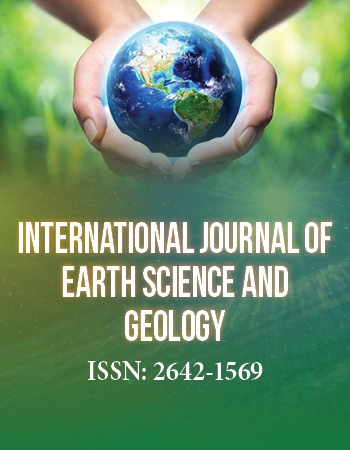Research Article
Sedimentological Characteristics of the Barail Arenaceous Unit of Makum-North Hapjan Oil Field, Assam
1Department of Applied Geology, Dibrugarh University, Dibrugarh, Assam, India
2Department of Petroleum Technology, Dibrugarh University, Dibrugarh, Assam, India
3Pachhunga University College, Aizawl, Mizoram, India
4G & R Department of Oil India Ltd, Duliajan, Assam, India
*Corresponding author: Kashyap Borgohain, Department of Applied Geology, Dibrugarh University, Assam, India, Tel: +91-8638034534, E-mail: kashyapborgohain13@gmail.com
Received: December 9, 2018 Accepted: April 8, 2019 Published: April 15, 2019
Citation: Borgohain K, Borgohain P, Bharali B, Baruah J. Sedimentological Characteristics of the Barail Arenaceous Unit of Makum-North Hapjan Oil Field, Assam. Int J Earth Sci Geol. 2019; 1(2): 66-73. doi: 10.18689/ijeg-1000108
Copyright: © 2019 The Author(s). This work is licensed under a Creative Commons Attribution 4.0 International License, which permits unrestricted use, distribution, and reproduction in any medium, provided the original work is properly cited.
Abstract
Upper Assam Shelf is one of the major on-shore hydrocarbon producing basin in India. It comprises sediments of upper Paleocene to recent and rest unconformably over the Granitic Basement. The Barail Group (Oligocene) of rocks in this basin is characterized by hydrocarbon source rock as well as reservoir rock. The Barail Group of rocks is divided into Arenaceous Unit (lower) and Argillaceous Unit (upper) in Upper Assam basin. The Arenaceous Unit is considered as good reservoir rock, where as the upper Argillaceous Unit is considered as source rock. The aim of the present research work is to characterize the Barail Arenaceous Unit of Makum-North Hapjan oil field with respect to its mineralogical constituents and textural properties. The present study reveals that the Barail reservoir sandstones in Makum-North Hapjan oil field are sublithic-arenite varieties with moderately well sorted texture and deposited in a fluvio-deltaic environment under the intermittent influence of transgressive and regressive effects. The sediments were derived from multiple provenances primarily comprising of reworked sediments and low rank metamorphic rocks.
Keywords: Petrography; Texture; Barail reservoir rock; Assam.
Introduction
The Upper Assam Basin is situated in a unique geotectonic framework in the north-eastern part of India. It was formed as a result of inter-plate convergence between Indian and Eurasian plates. A thick pile of sediments was deposited in this basin ranging in age from Upper Cretaceous through Paleogene to Neogene time. From the economic point of view the study area is very important because tectonic deformation during collision and subsequent under-thrusting of the Indian plate below the Eurasian and Burmese plate resulted in development of favourable structures for hydrocarbon accumulation [1]. This Upper Assam basin has been producing hydrocarbon since more than one century. The Barail Sandstone Formation, which was deposited in the Oligocene time, is an important litho-unit of Tertiary sediments in the Upper Assam basin. It acts as a good reservoir for hydrocarbon accumulation and in a number of oil fields of Upper Assam basin. It is a thick fluvio-deltic Sandstone which is exposed along two different strips, in the south-eastern part of North Cachar Hills, i.e. to the South of Haflong-Disang thrust and secondly in parts of North of the Cachar and Karbi (Mikir) Hills i.e. to the north of Haflong-Disang thrust in Upper Assam. The main objective of this research paper is to characterize the porous media of Barail reservoir Sandstone of Makum-North Hapjan oil field, Upper Assam Shelf under the jurisdiction of Oil India Limited Duliajan.
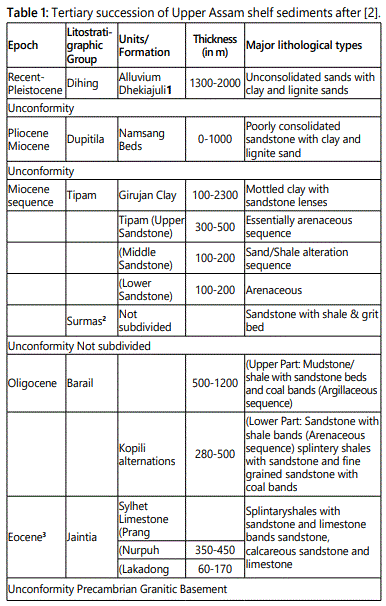
Methodology
To characterize the reservoir rock, detail petrographic study integrated with granulometric study, heavy mineral study and electrofacies analysis have been carried out. From the above findings an attempt has been made to characterize the Barail Sandstone of the study area with respect to its reservoir characterstics, provenance and depositional setting. Drill cores, cutting samples and wireline logs have been collected from OIL with due permission from management.
Results
Grain size analysis
Granulometric analysis has been done mainly to decipher the textural characteristics and the depositional environment of the Barail Sandstone in the study area. The present study reveals that the Sandstones are moderately well sorted with dominance of finer population. The fine skewed characteristics of the Sandstone indicate that the energy condition of the depositing agent was lower than the normal during sedimentation in the basin. The various bi-variate plot (Figures 1A-1F) [3-7] indicates that the sediments were deposited in a fluvio-deltic environment. This is also supported by log-log plot after [8] (Figure 1G). The CM diagrams (Figure 1G) [9] indicates that the sediments were transported primarily by graded suspension and deposited under the influence of river tractive currents. From various discriminante function (Table 2) it has been observed that the depositional site for Barail Sandstone was shallow agitated marine environment. Frequency distribution curves showing better sorting in the coarser end while few samples are showing better sorting in the fine end.
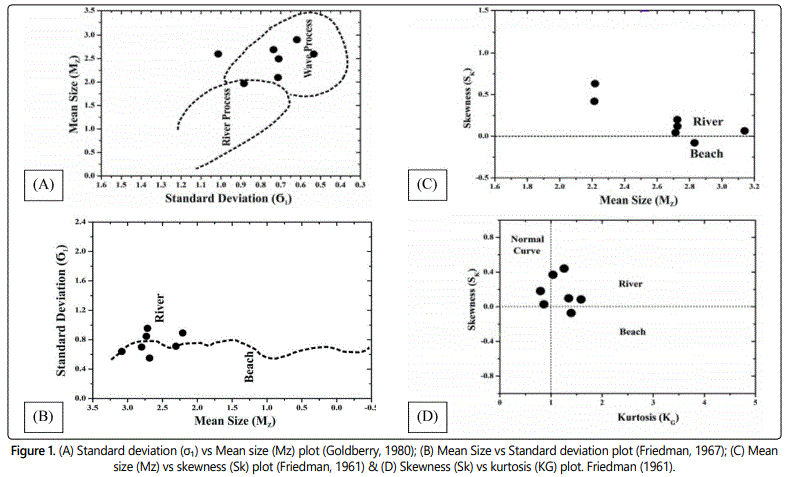
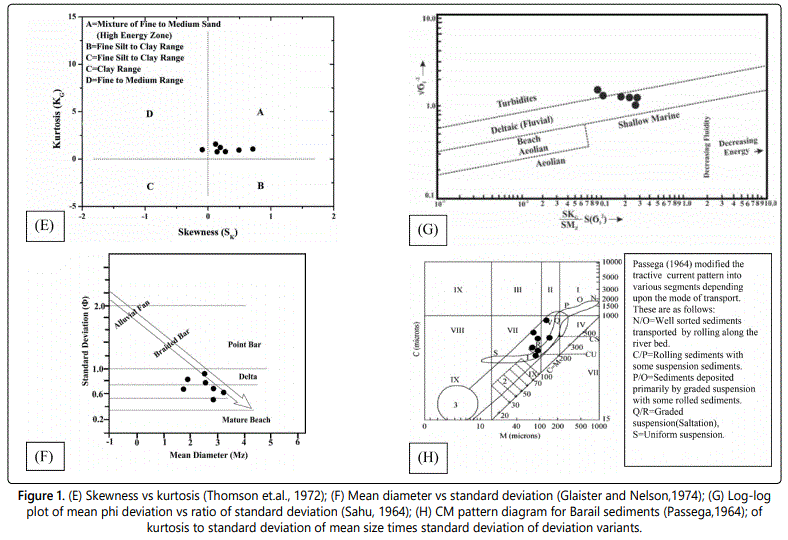

Petrography
Quantitative modal analysis of thin section based on petrography is commonly used to classify the Sandstones [10,11]. Modal counts showing the dominance of quartz (80.82-88.30%) followed by rock fragments (8.57-16.44%), feldspars (1.30-5.71%) and the matrix is ranging from (7.85-13.08%). The recalculated values of framework grains are plotted in the ternary plot of Q-F-L after [10] and Q-F-R plot after [11]. Most of the Barail samples are clustered in the field of sub-lithic aranite as represented in the figure 2A. Again in the Q-F-R ternary plot of Sandstone classification after [11], most of the Barail samples are clustered in the field of sublith-arenite as represented in the figure 2B.
Tectono-provenance of Barail Sandstone
Various types of quartz viz. monocrystalline (undulatory and non-undulatory) and polycrystalline (2-3 grains and >3 grains per quartz) can be used to decipher the nature of source rocks along with the climatic condition prevailing at the time of deposition. Petrographic analysis shows the abundance of Monocrystalline quartz (Non-Undulose) avg. 18.61% followed by Monocrystalline quartz (Undulose) avg. 16.8%, Polycrystalline quartz (>3 units) avg. 13.82% and Polycrystalline quartz (2-3 units) avg. 14.15%. Plotting the samples in diamond diagram (Figure 2C) proposed by Basu A et al. [12], it is found that all the samples fall within the field of low rank metamorphic rocks. It signifies that quartz minerals are mostly derived from metamorphic rocks [13]. Tortosa et al. proposed another provenance plot keeping the same parameter as earlier but introducing new fields of source rocks. In that plot (Figure 2D), it is observed that the sediments were sourced mainly from gneisses followed by slate and schist. For the demarcation of tectonic setting of the source area, the quantitative data are plotted in the ternary plot of Q-F-L (Figure 3E) [14] and Qm-F-Lt(Figure 3F) [15] plot, which indicates the derivation of the sediments from quartz rich recycled provenance. Moreover, less abundance of feldspars (avg. 1.2%) suggests long distance of transportation or reworking of the sediments. Qm-P-K plot (Figure 3A) [15] for clastic sedimentary rock shows mature nature of the sediments.
Paleoclimatic conditions
The Q-F-R plot (Figure 3B) [16] indicates high abundance of quartz and comparatively less amount of feldspar and rock fragments (Q-F-R: 84.76-3.02-12.22) which indicates the derivation of sediments from metamorphic sources in a humid climatic condition. Moreover the weathering index: WI=C × R (WI-Weathering index, C-Climate and R-Relief) [17] and the bi-variate plot of ln(Q/R) vs ln(Q/F) [18] (Figure 3C) reveals more contribution from the metamorphic source rocks than the plutonic with weathering indices between 1-2 suggesting a moderate nature of weathering under humid to sub-humid climatic condition. The observed climatic conditions are also supported by the bi-variate plot of ratios of (QTotal/F+RF) vs (QP/F+RF) [19] where samples are plotted in humid climatic conditions (Figure 3D).
Diagenesis of Barail Sandstone
In the present study, development of secondary porosity is characterized by presence of fractured quartz grain (Figure 6O). Corroded grains are generally associated with enlarged intergranular pores and results mainly from the dissolution of soluble mineral that evenly replaced the margin of the sand grains. Petrographic study of the samples indicates that the rocks have been undergone changes like compaction, precipitation of different types of cement, alteration, replacement and development of grain contact. Compaction of the sediments started with burial and progressively increases with depth. The mechanical compaction of sediments results the bending of mica flakes, which is one of the common mesogenetic change seen in most of the slides (Figure 4A). The compaction bring the grains into closer contacts along line or point boundaries that on pressure solution forms sutured contacts under more usual condition. The point or tangential contacts of sands suggests early burial stage of diagenesis that on increased in overburden load under deep burial stage come into closure contact along with concavo-convex grain boundary (Figure 6R) [20]. The locomorphic stages of diagenesis evidenced by the presence of long or concavo-convex contacts together with the precipitation of secondary chert. The cementation is brought by chemical precipitation of pore solution producing secondary overgrowth of quartz. The silica cement in the form of quartz overgrowth, recorded in certain samples of the present study influence the reservoir property of Sandstone. Quartz overgrowth reduces the porosity of the reservoir. Argillaceous cement is dominant in most of the slides. The low grade metamorphic rock fragments are squeezed to generate dispersed pseudomatrix (Figure 4D). One of the important diagenetic changes that have been recorded frequently in the Sandstone of the present study is the partial replacement and dissolution of the framework grain by the cementing material. Quartz replacement proceeds along the periphery of grains. As a result the replaced part of the grain is occupied by replacing front. Such replacement process enhances the porosity of the reservoir sands. Chert both authigenic and detrital varities are observed (Figures 4F and 5I). Formation of diagenetic mica at the expense of argillaceous cement is one of the important diagenetic changes recorded and it may reduce porosity as well as permeability in the Sandstone (Figure 5J). Authigenesis of mica as observed in certain samples of the present study is indicative of phyllomorphic stages of diagenesis.
Heavy minerals
The morphological characters of the non-opaque heavy minerals of Barail Sandstone are as follows:
Zircon: Zircon grains are mostly euhedral but subhedral grains are also present. Some rounded grains are also encountered. Both long, short and prismatic grains are abundant. Grains are usually colourless. Broken grains are frequently seen and some show strain effect. Most of the grains show zoning effect. Extinction is parallel.
Garnet: Garnets are easily identifiable because of their high relief and isotropic nature. They are rounded to sub rounded in appearance.
Tourmaline: Tourmaline grains are light brown to colourless in appearance. Grains are mostly subhedral to sub rounded. Pleochroism is seen. Extinction is parallel. Some grains observed were slender.
Rutile: Rutile grains are generally dark red to radish brown in colour. Most of the grains are sub-rounded. Extinction is parallel.
Kyanite: Kyanite grains are angular, bladed or prismatic, dominantly colourless, weakly pleochroic and exhibit characteristic cross-fractures and step-like features.
Chlorite: Chlorite appears as greenish in colour, the colour being somewhat dirty green.
Hornblende: Grains are green to greenish brown in colour. Most of them are sub angular prismatic. Distinctly pleochroic. Some grains show overgrowth.
Staurolite: Staurolite grain is dark yellowish brown in appearance. The grains are usually irregular and angular. The grains are easily identifiable because of their high relief.
Opaque minerals: Due to lack of characteristic optical properties the opaque minerals could not be described. However some can be distinguished as hematite and magnetite.
It is observed that except the ultrastable minerals (Rutile, Zircon, Tourmaline), most of the heavy minerals are angular to sub-angular and irregular in form. It indicates the short distance of transportation of the sediments on the other hand the textural characteristics such as broken zircon grains, rounded and sub-rounded zircon minerals were observed with well defined grain boundaries, indicating that the sediments were under the effect of long distance of transport. The dominance of garnet, kyanite and staurolite suggests that a significant proportion of the sediments were derived from metamorphic rocks. Some zircon were rounded which supports the fact that they must have been contributed by reworked sediments (Figure 7B). The presence of zircon, tourmaline, rutile and hornblende suggests that the sediments were derived from igneous rock. From the overall study of the heavy mineral content and their distribution in the Sandstone of Barail Group in the present study, it may be concluded that these sediments were derived from varied source. However, the metamorphic sources have contributed the major portion of the sediments than igneous source.
Well log analysis
The Barail Sandstone in the study area is composed of alternate beds of Sandstone and Shale. In certain places, sandy-shale as well as shaly-sand is also reported. From the overall analysis it can be inferred that the study area is influenced by transgressive and regressive environment of the basin and also by overbank flow. Well-B and bottom part of well-A is characterized by frequent alternation of sand and shale beds which indicates local and frequent fluctuation of the sea-level at the depositional basin. Shale beds were deposited during transgression where as sandstone beds were deposited during regression. Well-C and top part of Well-A is characterized by sandy shale and shaly sand facies. These indicate overbank and crevasse splay deposits which are formed when a stream breaks its natural or artificial levees and deposits its sediments on a floodplain. Thus from the overall log analysis it can be interpretated that the depositional environment of the study area is fluvio-deltaic.

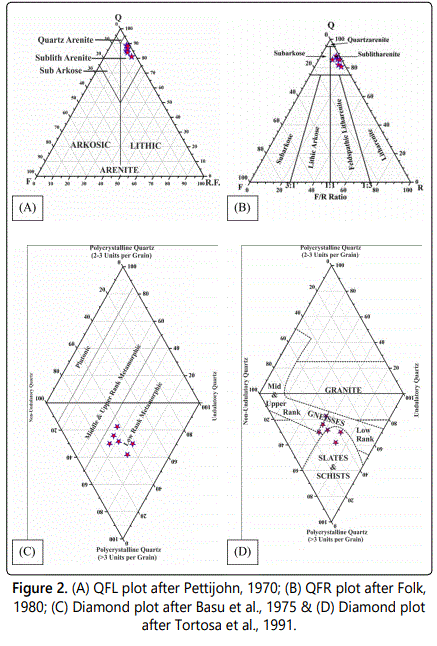
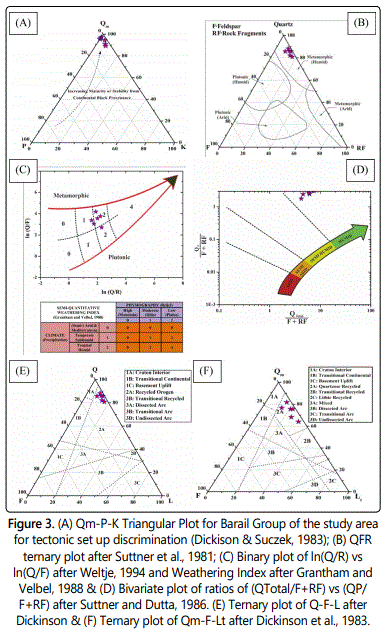
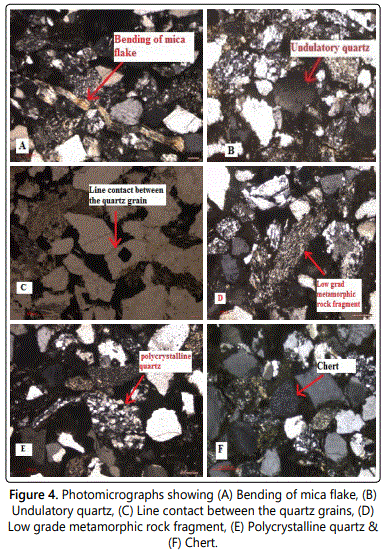
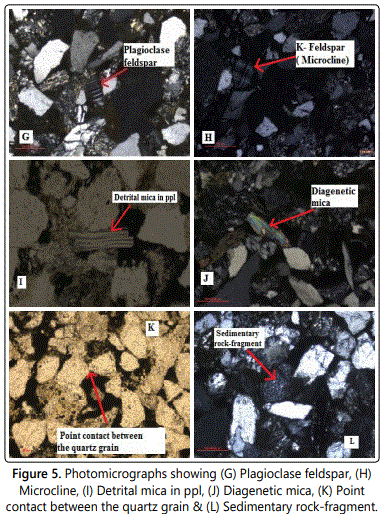
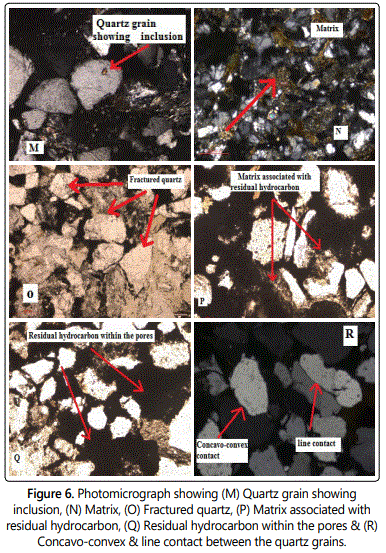
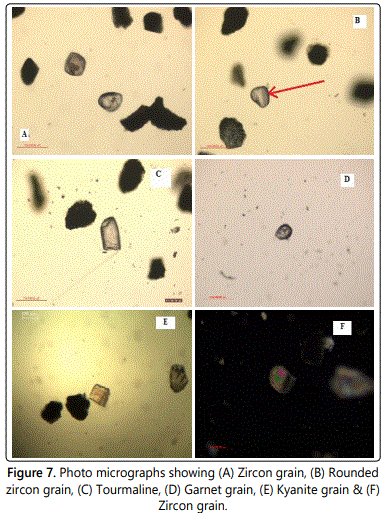
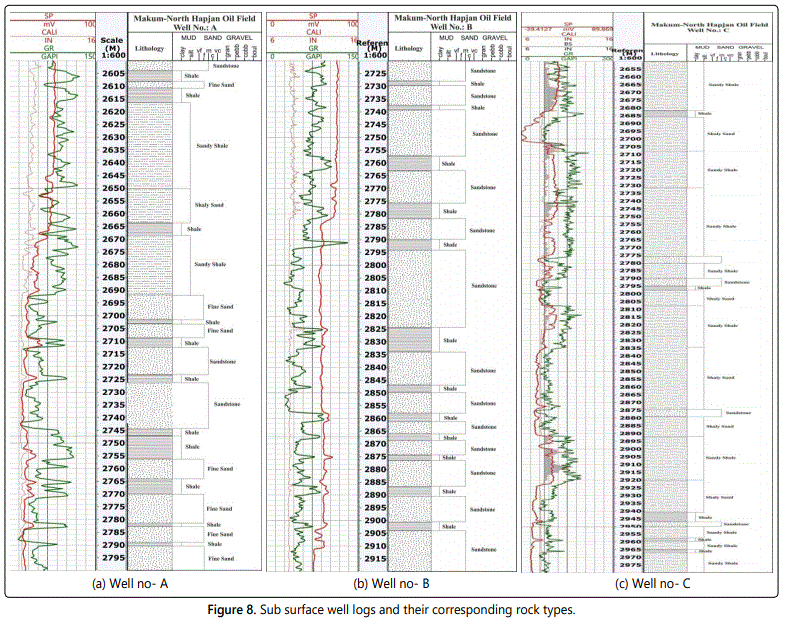
Conclusion
In the present work an attempt has been made to characterize the reservoir rock of the Barail Arenaceous Unit of Makum-North Hapjan oil field under Oil India Limitedʼs (OIL) operational area.
The petrographic study suggests that Barail Sandstones are mainly sublithic-arenite variety and are derived from quartzose recycled and low rank metamorphic sources. The Sandstones have undergone distinct diagenetic alterations which have made it a good reservoir. Dissolution of framework grains by cementing materials, intra-granular fracturing, and corrosion along grain boundaries are some of the important diagenetic changes that enhances the reservoir quality of the Sandstone. Moreover, the moderately well sorted texture with higher percentage of quartz made the reservoir highly productive. Heavy mineral analysis indicates that the sediments were derived from multiple sources.
Grain size analysis suggests that Sandstones are moderate to moderately well sorted and deposited in a river dominated deltaic environment. Electrofacies analysis infers frequent shifting of shoreline in the depositional setting. It suggests transgression and regression effects in the depositional site with overbank flow and crevasses splay deposits. Blocky signature of GR logs indicates braided channel deposits whereas fining upward sequence indicates the transgression effect.
Finally, from all the analysis, it can be concluded that the Barail reservoir Sandstones in Makum-North Hapjan oil field are sublithic-arenite type with moderately well sorted texture and deposited in a fluvio-deltaic environment under the intermittent influence of transgressive and regressive effects. The sediments were derived from multiple provenances, where sedimentary and low rank metamorphic sources are dominating.
Acknowledgement
The authors are grateful to the authorities of Oil India Limited Duliajan, Assam for providing sub-surface samples and relevant information to carry out this study and to publish this manuscript in research journal.
References
- Ranga Rao A. Geology and Hydrocarbon Potential of a part of AssamArakan Basin and its adjacent region. Pet Asia J. 1983; 6: 127–158.
- Goldbery R. Use of Grain-Size Frequency Data to Interpret the Depositional Environment of the Pliocene Pleshet Formation, Beer Sheva, Israel. Journal of Sedimentary Research. 1980; 50(3): 843–856. doi: 10.1306/212F7B08-2B24-11D7-8648000102C1865D
- Friedman GM. Dynamic processes and statistical parameters compared for size frequency distribution of Beach and river sands. Journal of Sedimentary Research. 1967; 37(2): 327–354. doi: 10.1306/74D716CC2B21-11D7-8648000102C1865D
- Friedman GM. Distinction between dune, beach, and river sands from their textural characteristics. Journal of Sedimentary Research. 1961; 31(4): 514–529. doi: 10.1306/74D70BCD-2B21-11D7-8648000102C1865D
- Thompson R, Battarbee RW, OʼSullivan PE, Oldfield F. Magnetic susceptibility of lake sediments. Limnology and Oceanography. 1975; 20(5): 687–698. doi: 10.4319/lo.1975.20.5.0687
- Glaister RP, Nelson HW. Grain-size distributions, an aid in facies identification. Bulletin of Canadian Petroleum Geology. 1974; 22(3): 203–240.
- Sahu BK. Depositional Mechanism from the Size Analysis of Clastic Sediments. Journal of Sedimentary Research. 1964; 34(1): 73–83. doi: 10.1306/74D70FCE-2B21-11D7-8648000102C1865D
- Passega R. Grain size representation by CM patterns as geological tool. Journal of Sedimentary Research. 1964; 34(4): 830–847. doi: 10.1306/74D711A4-2B21-11D7-8648000102C1865D
- Pettijohn FJ, Potter PE, Siever R. Sand and Sandstones. New York, Springer-Verlag, 1972.
- Folk RL. Petrology of sedimentary rocks. Hemphll Publishing Company, Austin. 1980.
- Basu A, Young SW, Suttner LJ, James WC, Mack GH. Re-evaluation of the use of undulatory extinction and polycrystallinity in detrital quartz for provenance interpretation. Journal of Sedimentary Research. 1975; 45(4): 873–882. doi: 10.1306/212F6E6F-2B24-11D7-8648000102C1865D
- Tortosa A, Palomares M, Arribas J. Quartz grain types in Holocene deposits from the Spanish Central System: some problems in provenance analysis. Geological Society of London. 1991; 57: 47–54. doi: 10.1144/GSL.SP.1991.057.01.05
- Dickinson WR, Suczeck CA. Plate tectonics and sandstone compositions. AAPG Bulletin. 1979; 63(12): 2164–2182.
- Dickinson WR. Interpreting provenance relations from detrital modes of sandstones. In: Zuffa GG (eds). Provenance of Arenites. 1985; 148: 333–361. doi: 10.1007/978-94-017-2809-6_15
- Suttner LJ, Basu A, Mack GH. Climate and the origin of quartz arenites. Journal of Sedimentary Research. 1981; 51(4): 1235–1246. doi: 10.1306/212F7E73-2B24-11D7-8648000102C1865D
- Grantham JH, Velbel MA. The influence of climate and topography on rock-fragment abundance in modern fluival sands of the southern Blue Ridge Mountains, North Carolina. Journal of Sedimentary Research. 1988; 58(2): 219–227. doi: 10.1306/212F8D5F-2B24-11D7-8648000102C1865D
- Weltje GJ. Provenance and dispersal of sand-sized sediments: reconstruction of dispersal patterns and sources of sand-sized sediments by means of inverse modelling techniques. Geologica Ultraiectina. 1994; 121: 1-208.
- Suttner LJ, Dutta PK. Alluvial sandstone composition and paleoclimate; I, Framework mineralogy. Journal of Sedimentary Research. 1986; 56(3): 329-345. doi: 10.1306/212F8909-2B24-11D7-8648000102C1865D
- Blatt H, Middleton G, Murray R. Origin of Sedimentary Rocks. 2nd edition, Prentice-Hall, New Jersey, 1980.

